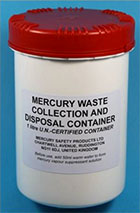Featured
Mercury Spillage Kit Mercury Spillage Kits& Accessories Personal Protection Mercury Waste
Containers Mercury Exposure
Monitoring Consumer Products FREE Downloads
Instructions & Mercury Safety Policies HERE
COSHH regulations say
Wherever mercury is used you must have the equipment to clear up a mercury spillage
Dealing with spillages
Using a Mercury Safety Products Spillage Kit
Mercury Spillage on a Hard Surface e.g. Floor:
In the event of spillage, try to confine the affected area to a minimum. Put on protective gloves and mask to reduce dust inhalation. Increase ventilation by opening a window. Try to reduce the spread of the spill as much as possible; in particular avoid getting mercury on the floor. Never use a vacum cleaner or aspirator to pick up mercury and never dispose of mercury in the 'Sharps' bin. Using the scoop, move the globules of mercury together to form one large pool. Pick up as much of this as possible using the syringe and place in the waste container. Return the syringe to the spillage kit.
Make a paste of equal amounts of the absorbent paste forming powders with a little water and spread onto the spillage area. Keep mixing the paste on the spillage area using the brush and scoop for two or three minutes - it can be used wet and does not need to dry out. Then brush the paste into the scoop and transfer it to the waste container, wiping any residual paste from the brush and scoop on the lip of the waste container, which is then capped tightly. Replace in the spillage kit and store this in well- ventilated place away from sources of heat.
Mercury Spillage on a Fabric Surface e.g. Carpet or Bedding (Can also be used on hard surfaces to avoid using paste)
Skin contact with mercury should be avoided - if bedding is affected, move the patient away if possible. Put on protective gloves and increase ventilation. Recover as much of the loose mercury as possible with the syringe and place in the waste container. Return the syringe to the spillage kit.
Break off a piece of alloy wool to form a sphere of 1" - 2.5cm diam. Holding the piece of alloy wool between finger and thumb, press it firmly against a hard surface eg work surface, to flatten one side. Place this flattened area gently on top of the loose mercury and leave it for 20 seconds or so. The mercury will adhere to the alloy wool and will be picked up. Then move the alloy wool pad to the next area of mercury droplets. Place the contaminated alloy wool in the waste container. Repeat this until all visible mercury droplets have been removed, using more 'buds' of alloy wool if necessary.
Decontamination procedure (Hard floors only)
To a third of a bucket of warm water add a drop of washing up liquid and two heaped teaspoonsful each of the paste component powders, stirring to make a suspension. Use a mop to apply this to hard floors, doing this perhaps every month or two months. After most of the suspension has been mopped off, clean the floor with a proprietary cleaner.
When the waste container is full, dispose of it via a Dental Metal Reclaiming company; through your health services organisation, hospital estates office or pharmacy or as toxic waste.
Procedures based on COSHH and British Dental Association guidelines.

